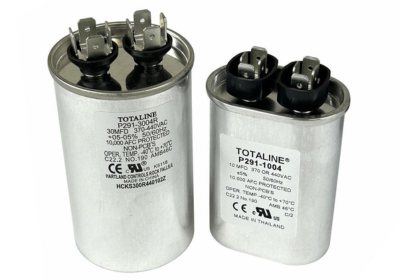Capacitors and transformers play a crucial role in HVAC electrical systems, ensuring motors, compressors, and controls operate efficiently. Understanding their function is essential for troubleshooting and maintenance.
In this article:
What is a HVAC Capacitor?

An HVAC capacitor is an electrical component that stores and releases energy to help start and run motors in heating, ventilation, and air conditioning (HVAC) systems. It provides the necessary electrical boost to power the compressor, blower motor, and condenser fan motor efficiently.
Types of HVAC Capacitors:
The following are types of HVAC Capacitors :
- Start Capacitor – Gives a high-voltage boost to start the motor.
- Run Capacitor – Helps the motor run smoothly and efficiently.
- Dual-Run Capacitor – A single unit that powers both the compressor and fan motor.
Also Read : Types of Capacitors in detail.
What is the function of a HVAC Capacitor?
Starting the Motor:
Provides a high-voltage boost to start the compressor, blower motor, or condenser fan motor.
Running the Motor:
Maintains a steady flow of electricity to keep the motor running smoothly.
Improving Efficiency:
Reduces power fluctuations and prevents motors from overheating or stalling.
Enhancing Longevity:
Helps motors operate at the correct voltage, extending their lifespan.
Why is a Capacitor important in HVAC?
- Ensures motors start quickly and operate efficiently.
- Prevents overheating and motor failure.
- Helps maintain a steady electrical supply to HVAC components.
Symptoms of a Bad HVAC Capacitor:
- AC Won’t Start or Delayed Start
- Weak or Warm Airflow
- Clicking or Humming Noises
- AC Turns Off Randomly
- Fan or Compressor Not Running
- Burning Smell or Overheating
- Visible Damage on the Capacitor
How to test HVAC Capacitor?(Step-by-Step Guide)
A faulty HVAC capacitor can cause problems like the AC not starting, weak cooling, or strange noises. You can test the capacitor using a digital multimeter to check its capacitance.
Step 1: Safety Precautions
🔹 Turn Off Power – Switch off the AC unit at the breaker panel to avoid electrical shock.
🔹 Discharge the Capacitor – Use an insulated screwdriver to short the capacitor terminals (hold the metal shaft across both terminals for a second).
Step 2: Remove the Capacitor
- Open the HVAC unit panel to access the capacitor (usually in the outdoor condenser unit).
- Locate the capacitor (a cylindrical or oval metal component).
- Disconnect the wires (take a photo beforehand for reconnection reference).
Step 3: Test the Capacitor Using a Multimeter
Method 1: Capacitance Test (Recommended)
- Set the multimeter to capacitance mode (MFD or µF).
- Connect the multimeter leads to the capacitor terminals:
- HERM (Hermetic) = Compressor terminal
- FAN = Fan terminal
- C (Common) = Common terminal
- Compare the reading to the capacitor’s labeled capacitance (e.g., 35 µF or 5 µF).
✅ Good Capacitor: Reading is within 6% of the rated value.
❌ Bad Capacitor: Reading is much lower or shows “0” (replace capacitor).
Method 2: Resistance Test (Ohms Mode)
- Set the multimeter to Ohms (Ω).
- Touch the probes to the capacitor terminals.
- If the resistance starts low and gradually increases, the capacitor is good.
- If the reading stays at 0 or doesn’t change, the capacitor is bad.
Step 4: Replace the Capacitor (If Faulty)
- Buy a new capacitor with the same voltage and microfarad rating.
- Reconnect wires in the correct terminals.
- Secure the capacitor in place and restore power.
Troubleshooting HVAC Capacitor:
| Issue | Possible Cause | Solution |
|---|---|---|
| AC won’t start or delayed start | Faulty start capacitor | Test and replace the capacitor |
| Weak or warm airflow | Run capacitor failing | Check capacitance and replace if low |
| Clicking or humming noises | Capacitor not providing enough power | Test with a multimeter and replace |
| AC turns off randomly | Overheating or weak capacitor | Inspect and replace capacitor |
| Fan or compressor not running | Dead capacitor | Replace with a new one |
| Burning smell or overheating | Capacitor overheating or short-circuited | Shut off power, inspect, and replace |
| Visible damage on capacitor | Swollen, cracked, or leaking capacitor | Replace immediately |
Conclusion:
Testing an HVAC capacitor with a multimeter is easy and helps prevent costly AC failures. If the capacitor is bad, replacing it quickly restores AC efficiency. 🚀
Frequently Asked Questions?
1. What does an AC Capacitor do?
An AC capacitor is an electrical component in an air conditioning system that stores and releases energy to help the compressor, blower motor, and condenser fan motor start and run efficiently.
2. What happens if an AC Capacitor fails?
- AC won’t start or struggles to turn on.
- Weak airflow or warm air blowing from vents.
- Humming or clicking noises from the unit.
- The fan or compressor won’t run properly.
3. How much does an AC Capacitor cost?
The cost of an AC capacitor depends on its type, brand, and capacitance rating. Here’s a breakdown:
| Type of Capacitor | Price Range (USD) |
|---|---|
| Start Capacitor | $10 – $50 |
| Run Capacitor | $10 – $60 |
| Dual-Run Capacitor | $15 – $80 |
Other Courses:



